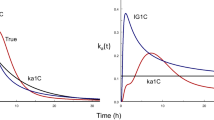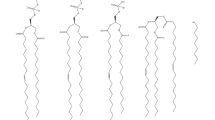Abstract
The two-compartment model of Rowland et al.,(2) has been extended by replacing first order elimination with Michaelis-Menten elimination kinetics. All of the equations for steady-state concentrations and clearances for zero order (constant rate) input orally (into compartment #2) and intravenously (into compartment #1) are derived and reported. The steady-state concentration in compartment #1, following intravenous administration, is shown to be a nonlinear function of maximal velocity of metabolism, Vm,the Michaelis constant, Km,and liver blood flow, Q;and, following oral administration is dependent only upon Vm and Km and is independent of Q.However, oral bioavailability is a function of Vm, Km,and Q.The model allows physiologic pharmacokinetic interpretation of both linear and nonlinear data; and, together with simple modification of the model, can explain much observed pharmacokinetic data to date particularly for first-pass drugs. Future articles in the series will be concerned with single doses, evaluation of literature data in terms of the model, application of the theory in toxicology and in clinical pharmacokinetics and therapeutics.
Similar content being viewed by others
References
M. Rowland. Influence of route of administration on drug availability.J. Pharm. Sci. 67:70–74 (1972).
M. Rowland, L. Z. Benet, and E. G. Graham. Clearance concepts in pharmacokinetics.J. Pharmacokinet. Biopharm. 1:123–136 (1973).
G. R. Wilkinson and D. G. Shand. A physiological approach to hepatic drug clearance.Clin. Pharmacol. Ther. 18:377–390 (1975).
D. G. Shand, D. M. Kornhauser, and G. R. Wilkinson. Effects of route of administration and blood flow on hepatic drug elimination.J. Pharmacol. Exp. Ther. 195:424–432 (1975).
K. S. Pang and M. Rowland. Hepatic clearance of drugs I. Theoretical consideration of a “well-stirred” model and a “parallel-tube” model. Influence of heptatic blood flow, plasma and blood cell binding, and the hepatocellular enzymatic activity on hepatic drug clearance.J. Pharmacokinet. Biopharm. 5:625–653 (1977).
K. S. Pang and M. Rowland. Hepatic clearance of drugs II. Experimental evidence for acceptance of the “well-stirred” model over the “parallel-tube” model using lodocaine in the perfused rat liverin situ preparation.J. Pharmacokinet. Biopharm. 5:655–680 (1977).
K. S. Pang and M. Rowland. Hepatic clearance of drugs III. Additional experimental evidence supporting the “well-stirred” model, using metabolite (MEGX) generated from lidocaine under varying hepatic blood flow rates and linear conditions in the perfused rat liverin situ preparation.J. Pharmacokinet. Biopharm. 5:681–699 (1977).
G. R. Wilkinson, A. J. J. Wood, R. A. Branch, and D. G. Shand. Intrinsic hepatic clearance in cirrhosis.Gastroenterology 75:347–348 (1978).
K. S. Pang and J. R. Gillette. A theoretical examination of the effects of gut wall metabolism, hepatic elimination and enterohepatic cycling on estimates of bioavailability and hepatic blood flow.J. Pharmacokinet. Biopharm. 6:355–367 (1978).
K. S. Pang. Hepatic clearances of drugs and metabolites.Trends in Pharmacological Sciences (June, 1980), pp. 247–251.
A. B. Ahmad, P. N. Bennett, and M. Rowland. Models of hepatic drug clearance: discrimination between the “well-stirred” and “parallel-tube” models.J. Pharm. Pharmacol. 35:219–224 (1983).
M. Rowland. Protein binding and drug clearance.Clin. Pharmacokinet. 9 (Suppl. 1):10–17 (1984).
S. M. Pond and T. M. Tozer. First-pass elimination: Basic concepts and clinical consequences.Clin. pharmacokinet. 9:1–25 (1984).
L. Bass, S. Keiding, K. Winkler, and N. Tygstrup. Enzymatic elimination of substrates flowing through the intact liver.J. Theor. Biol. 61: 393–409 (1976).
S. Keiding, S. Johanson, K. Winkler, K. Tønnesen, and M. Tygstrup. Michaelis-Menten kinetics of the galactose elimination by the isolated perfused pig liver.Am. J. Physiol. 230:1302–1313 (1976).
L. Bass and J. I. Bracken. Time dependent elimination of substrates flowing through the liver and kidney.J. Theor. Biol. 67:637–652 (1977).
S. Keiding and E. Chiarantini. Effect of sinusoidal perfusion on galactose elimination kinetics in perfused rat liver.J. Pharmacol. Exp. Ther. 177:246–255 (1978).
L. Bass and A. J. Brackan. Hepatic elimination of flowing substrates: The distributed model.J. Theor. Biol. 72:161–184 (1978).
L. Bass. Current models of hepatic elimination.Gastroenterology 76:1504–1505 (1979).
L. Bass and P. Robinson. Applied mathematics Reprint No. 110, Dept. of Mathematics, University of Queensland, Brisbane, Australia, 1979.
L. Bass and P. Robinson. How small is the functional variability of liver sinusoids?J. Theor. Biol. 81:761–769 (1979).
L. Bass. On the location of cellular functions in perfused organs.J. Theor. Biol. 82:347–351 (1980).
L. Bass. Flow dependence of first order uptake of substances by heterogeneous perfused organs.J. Theor. Biol. 86:365–376 (1980).
S. Johansen and S. Keiding. A family of models for the elimination of substrate in the liver. Reprint No. 4, Institute of Mathematical Statistics, University of Copenhagen, Copenhagen, Denmark, 1980.
L. Bass and K. Winkler. A method of determining intrinsic hepatic clearance from the first-pass effect.Clin. Exp. Pharmacol. Physiol. 7:339–343 (1980).
L. Bass and P. J. Robinson. Effects of capillary heterogeneity on rates of steady uptake of substances by the intact liver.Microvasc. Res. 22:43–57 (1981).
L. Bass. Functional zones in rat liver: The degree of overlap.J. Theor. Biol. 89:303–319 (1981).
E. Bechgaard, S. Keiding, J. Lund, and L. A. Christiensen. Hepatic elimination of femoxetine in pig.Acta Pharmacol. Toxicol. 52:1–7 (1983).
S. Keiding, H. Mengel, and J. Lund. Hepatic elimination of femoxetine in pig during intravenous infusion.Acta Pharmacol. et Toxicol. 52:234–237 (1983).
J. G. Wagner, G. J. Szpunar, and J. J. Ferry. Commentary: Exact mathematical equivalence of the venous equilibration (“well-stirred”) model, the sinusoidal perfusion (“parallel-tube”) model and a specific two compartment open model.Drug Metab. Dispos. 12:385–388 (1984).
J. G. Wagner. Comparison of nonlinear pharmacokinetic parameters estimated from the sinusoidal perfusion and venous equilibration models.Biopharm. Drug Dispos., in press, (1985).
G. T. Tucker. Principles of pharmacokinetics.Therapeutic Drug Monitoring, Churchill Livingstone, New York, 1981, Chap. 3, pp. 31–53.
R. L. Dedrick and D. D. Forrester. Blood flow limitations in interpreting Michaelis constants for ethanol oxidationin vivo.Biochem. Pharmacol. 22:1133–1140 (1973).
D. Perrier and M. Gibaldi. Clearance and biologic half-life as indices of intrinsic hepatic metabolism.J. Pharmacol. Exp. Ther. 191:17–24 (1974).
J. M. Strong, J. S. Dutcher, W. K. Lee, and A. J. Atkinson. Pharmacokinetics in man of theN-acetylated metabolite of procainamide.J. Pharmacokinet. Biopharm. 3:223–235 (1975).
R. J. Sawchuk and J. S. Rector. Steady-state plasma concentrations as a function of the absorption rate and dosing interval for drugs exhibiting concentration-dependent clearance: consequences for phenytoin therapy.J. Pharmacokinet. Biopharm. 7:543–555 (1979).
J. G. Wagner. A safe method of rapidly achieving plasma concentration plateaus.Clin. Pharmacol. Ther. 16:691–700 (1974).
J. G. Wagner. Predictability of verapamil steady-state plasma levels from single-dose data explained.Clin. Pharmacol. Ther. 36:1–4 (1984).
G. M. Wilkinson. Statistical estimation in enzyme kinetics.Biochem. J. 80:324–332 (1961).
G. Levy and A. Yacobi. Effect of plasma protein binding on elimination of warfarin.J. Pharm. Sci. 63:805–806 (1974).
S. B. Freedman, D. R. Richmond, J. J. Ashely, and D. T. Kelly. Verapamil kinetics in normal subjects and patients with coronary artery spasm.Clin. Pharmacol. Ther. 30:644–652 (1981).
A. J. Sedman and J. G. Wagner. Quantitative pooling of Michaelis-Menten equations in models with parallel metabolite formation paths.J. Pharmacokinet. Biopharm. 2:149–160 (1974).
J. G. Wagner.Fundamentals of Clinical Pharmacokinetics, 1st ed., Drug Intelligence Publications, Inc., Hamilton, IL, 1975, pp. 265–267.
J. G. Wagner, P. K. Wilkinson, A. J. Sedman, D. R. Kay, and D. J. Winkler. Elimination of alcohol from human blood.J. Pharm. Sci. 65:152–154 (1976).
P. K. Wilkinson, A. J. Sedman, E. Sakmar, D. R. Kay, and J. G. Wagner. Pharmacokinetics of ethanol after oral administration in the fasting state.J. Pharmacokinet. Biopharm. 5:207–229 (1977).
Author information
Authors and Affiliations
Rights and permissions
About this article
Cite this article
Wagner, J.G., Szpunar, G.J. & Ferry, J.J. A nonlinear physiologic pharmacokinetic model: I. Steady-state. Journal of Pharmacokinetics and Biopharmaceutics 13, 73–92 (1985). https://doi.org/10.1007/BF01073657
Received:
Revised:
Published:
Issue Date:
DOI: https://doi.org/10.1007/BF01073657




